What is SEO? How to Optimize for Search Engines Like Google
SEO (Search Engine Optimization) is the practice of optimizing content to be discovered through a search engine’s organic search results.
The benefits are obvious: free, passive traffic to your website, month after month.

The Ahrefs Blog ranks for 118k keywords and gets 252k visits from Google every month.
But how do you optimize your content for SEO, and what “ranking factors” actually matter?
To answer that, we first need to understand how search engines work.
https://www.youtube.com/watch?v=R‑XxAk8-OXY
Search engines are like libraries for the digital age.
Instead of storing copies of books, they store copies of web pages.
When you type a query into a search engine, it looks through all the pages in its index and tries to return the most relevant results.
To do this, it uses a computer program called an algorithm.
Nobody knows exactly how these algorithms work, but we do have clues, at least from Google.
Here’s what they say on their “How search works” page:
To give you the most useful information, Search algorithms look at many factors, including the words of your query, relevance and usability of pages, expertise of sources and your location and settings. The weight applied to each factor varies depending on the nature of your query – for example, the freshness of the content plays a bigger role in answering queries about current news topics than it does about dictionary definitions.
Speaking of Google, this is the search engine most of us use—at least for web searches. That’s because it has the most reliable algorithm by far.
That said, there are tons of other search engines you can optimize for.
In simple terms, SEO works by demonstrating to search engines that your content is the best result for the topic at hand.
This is because all search engines have the same goal: To show the best, most relevant results to their users.
Precisely how you do this depends on the search engine you’re optimizing for.
If you want more organic traffic to your web pages, then you need to understand and cater to Google’s algorithm. If you want more video views, then it’s all about YouTube’s algorithm.
Since each search engine has a different ranking algorithm, it’d be impossible to cover them all in this guide.
So, going forward, we’ll focus on how to rank in the biggest search engine of them all: Google.
Fun fact
Google has a market share of ~92%. That’s why it pays to optimize your website for Google instead of Bing, DuckDuckGo, or any other web search engine.
Google famously uses more than 200 ranking factors.
There was even talk way back in 2010 that there could be up to 10,000.
Nobody knows what all of these ranking factors are, but we do know some of them.
How? Because Google told us, and many people—including us—have studied the correlations between various factors and Google rankings.
We’ll discuss some of those shortly. But first, an important point:
Google ranks web pages, not web sites.
Just because your business makes stained glass windows doesn’t mean that every page on your site should rank for the query, “stained glass windows.”
You can rank for different keywords and topics with different pages.
Now let’s talk about some of the things that affect rankings and search engine visibility.
Crawlability
Before Google can even consider ranking your content, it first needs to know that it exists.
Google uses several ways to discover new content on the web, but the primary method is crawling. To put it simply, crawling is where Google follows links on the pages they already know about to those they haven’t seen before.
To do this, they use a computer program called a spider.
Let’s say that your homepage has a backlink from a website that’s already in Google’s index.
Next time they crawl that site, they’ll follow that link to discover your website’s homepage and likely add it to their index.
From there, they’ll crawl the links on your homepage to find other pages on your site.
That said, some things can block Google’s crawlers:
- Poor internal linking: Google relies on internal links to crawl all the pages on your site. Pages without internal links often won’t get crawled.
- Nofollowed internal links: Internal links with nofollow tags won’t get crawled by Google.
- Noindexed pages: You can exclude pages from Google’s index using a noindex meta tag or HTTP header. If other pages on your site only have internal links from noindexed pages, there’s a chance that Google won’t find them.
- Blocks in robots.txt: Robots.txt is a text file that tells Google where it can and can’t go on your website. If pages are blocked here, it won’t crawl them.
If you’re concerned about any of these issues on your site, consider running an SEO audit with a tool like Ahrefs Site Audit.
https://www.youtube.com/watch?v=LjinWqfGyVE
Mobile-friendliness
63% of Google searches come from mobile devices, and that number is growing every year.
Given that statistic, it probably comes as no surprise that in 2016, Google announced a ranking boost for mobile-friendly websites in its mobile search results.
Google also shifted to mobile-first indexing in 2018, meaning that they now use the mobile version of your page for indexing and ranking.
I think there’s some confusion. Some think we have two indexes, one for mobile pages & one for desktop pages. We have one. Most sites now, we do desktop-first indexing. Going forward, it’ll be mobile-first indexing https://t.co/7QtCgbWQGU pic.twitter.com/leV7ADhLoO
— Danny Sullivan (@dannysullivan) March 15, 2018
But here’s an even more critical statistic from Adobe:
Nearly 8 in 10 of consumers would stop engaging with content that doesn’t display well on their device
In other words, most people will likely hit the back button when a desktop version of a site loads on mobile.
That’s important because Google wants to keep its users satisfied. Pages that aren’t optimized for mobile lead to dissatisfaction. And even if you do rank and win the click, most people won’t stick around to consume your content.
You can check if your web pages are mobile-friendly with Google’s mobile-friendly testing tool.

If they aren’t, hire a developer to fix them.
Pagespeed
Pagespeed is how fast your page loads. It’s a ranking factor on desktop and mobile.
Why? Once again, Google wants to keep its users satisfied. If their users are clicking on search results that take too long to load, that leads to dissatisfaction.
To check the speed of your web pages, use Google’s Pagespeed Insights tool.
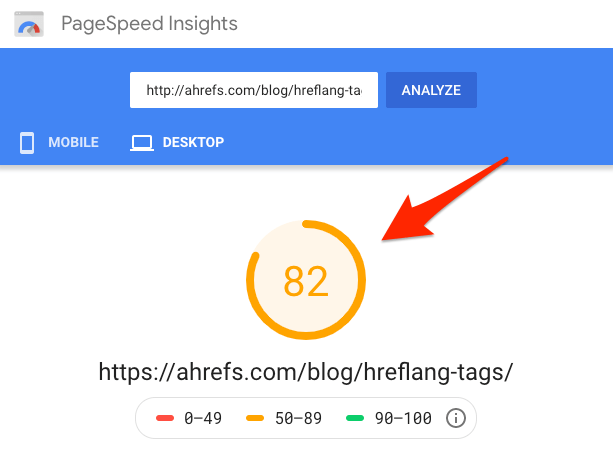
Alternatively, use Ahrefs Site Audit to check for slow-loading pages across your site.
Just head to the “Performance” report and look for the “Slow page” warning.

Search intent
Finding a keyword or keywords that you want to rank for is easy. Just paste a topic into a keyword research tool like Ahrefs Keywords Explorer, then look for relevant keyword ideas with search volume.

That said, what many people fail to consider is whether their page aligns with their chosen keyword’s search intent.
To demonstrate search intent, let’s look at an example.
Here are the current Google search results for the query “slow cooker recipes”:

Compare those with the results for the query “slow cooker”:
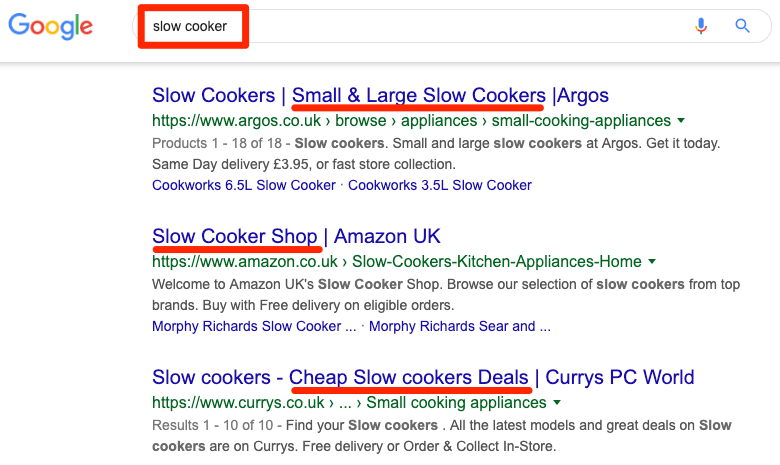
Despite the similarity between the two keywords, Google shows two completely different sets of search results. For “slow cooker recipes,” they show pages listing lots of recipes. For “slow cooker,” they show product listings and ecommerce category pages.
Google is interpreting the motive behind the query and showing results the user wants to see.
This is search intent in action.
How do you optimize for this?
Look at the top-ranking pages and ask yourself questions to identify the “3 C’s of search intent.”
- Content type: Are most of the results blog posts, product pages, category pages, landing pages, or something else?
- Content format: Is Google mainly ranking how-to guides, list-style articles, tutorials, comparisons, opinion pieces, or something entirely different? (Note. This one applies mainly to informational topics.)
- Content angle: Is there a common theme or unique selling point across the top-ranking pages? If so, this gives you some insight into what might be important to searchers.
Beyond this, you can also check for the presence (or not) of SERP features to infer intent.
For example, if there’s a featured snippet in the results, then this may indicate that the searcher is looking for information.

If you’re doing keyword research, you can filter for keywords with or without specific SERP features in Ahrefs Keywords Explorer.
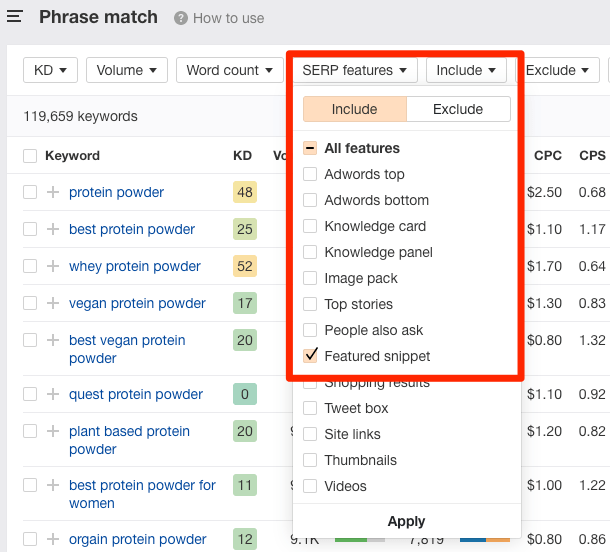
Recommended reading: What is Search Intent? A Complete Guide for Beginners
Backlinks
Google’s ranking algorithm is based on something called PageRank.
In simple terms, this interprets backlinks as votes. Generally speaking, pages with more votes tend to rank higher.
How do we know? Last year, we studied almost one billion web pages and found a clear correlation between referring domains (links from unique websites) and organic search traffic.

Long story short, backlinks matter if you want to rank for anything worthwhile.
The problem is that links can be challenging to build, especially to certain types of content like product pages.
There are tons of link building tactics but if you’re new to the game, aim to build links to your best informational content (e.g., a blog post or a free tool).
Here’s one way to do that:
Search for your target keyword on Google. Look for pages that aren’t as good as yours. Paste the URL of that page into our free backlink checker to see its top 100 links.
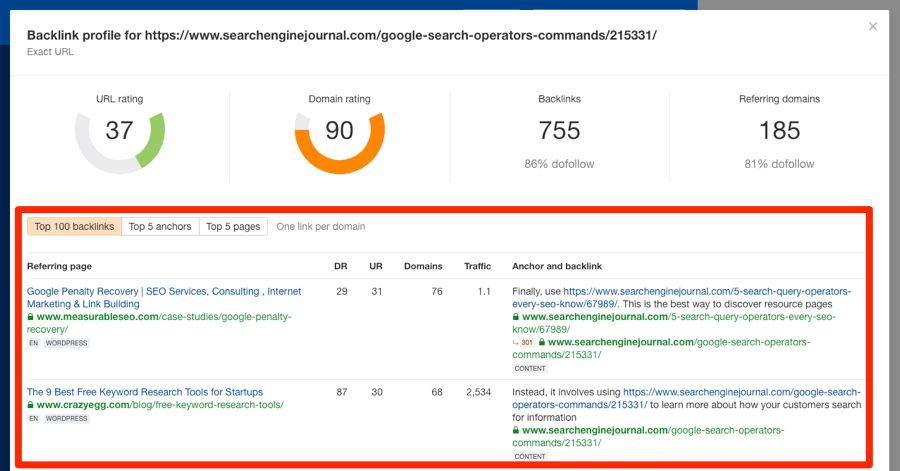
Consider reaching out to these people, explaining why your content is better, and ask if they’d swap out the link for yours.
This tactic is commonly known as the Skyscraper Technique.
Learn more about this technique, and other backlink building tactics, in the articles and videos below.
Authority
Not all backlinks are created equal. Some carry more weight than others.
This fact is built-in to the way PageRank works.
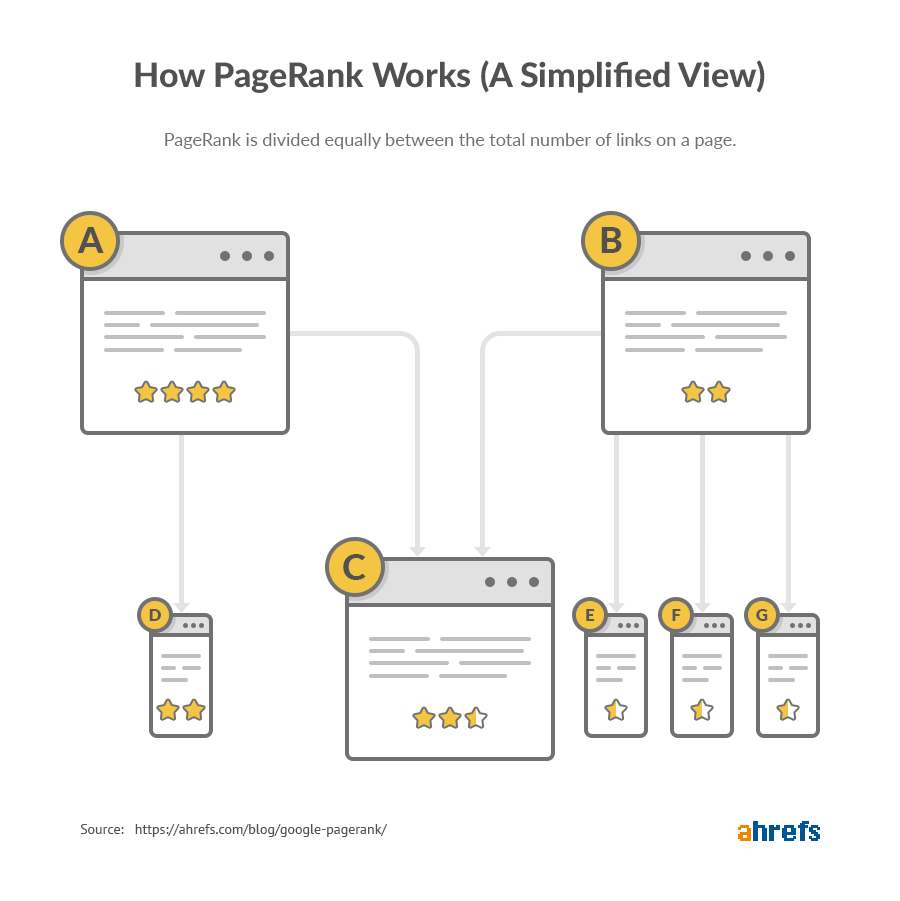
Generally speaking, backlinks from high-authority pages are stronger than those from low-authority pages.
Unfortunately, Google discontinued public PageRank scores in 2016. That means there’s no longer any way to see how much “authority” a web page has in Google’s eyes.
Luckily, there are similar metrics around, one of which is Ahrefs URL Rating (UR).
URL Rating runs on a scale from 0–100 and takes into account both the quantity and quality of backlinks to a web page.
When we studied the relationship between UR and organic search traffic, we found a clear positive correlation.
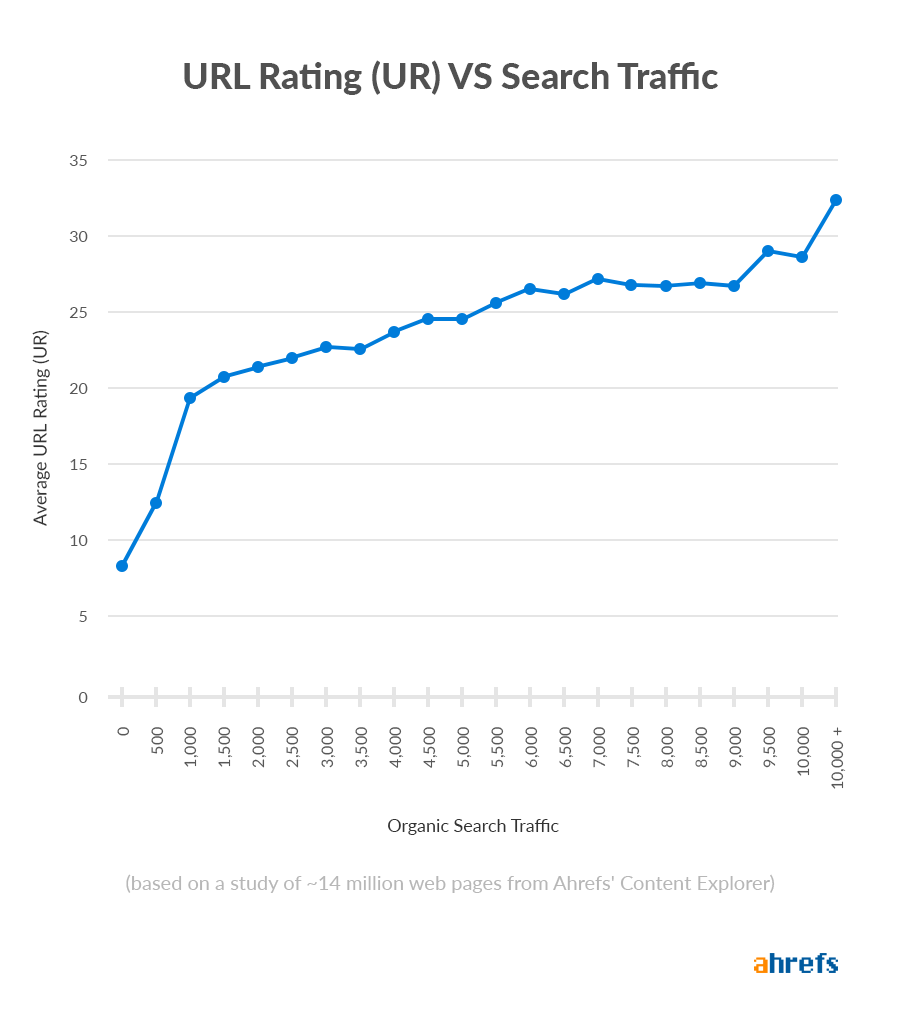
For that reason, when building backlinks to your content, you should prioritize the building of links from strong pages over weak ones.
If you’re analyzing competing pages for backlink opportunities in Ahrefs Site Explorer, the best way to do this is to look at the UR column in the “Backlinks” report.

Of course, backlinks aren’t the only way to boost the “authority” of a web page.
URL Rating (UR) also takes into account internal links, meaning that links from other pages on your site contribute to the authority of a page.
If you want to boost the “authority” of a particular page and are struggling to build backlinks to it, consider adding some relevant internal links from other high-authority pages.
To see your most authoritative pages, check the “Best by Links” report in Ahrefs Site Explorer.
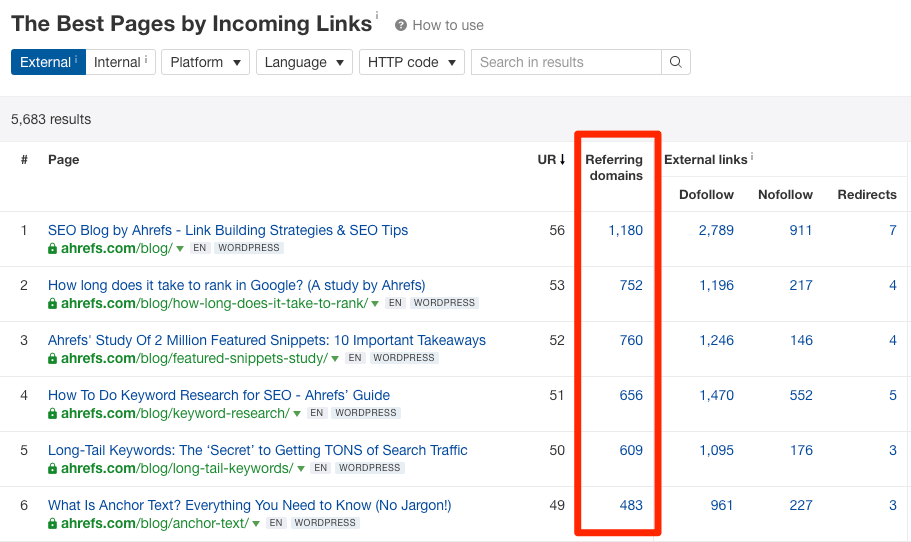
The golden rule here is not to shoehorn links where they don’t belong. Always link contextually.
This tactic offers a good way to boost the “authority” of pages with commercial value like product pages. You’ll often struggle to build backlinks to those pages directly.
Content quality
Google wants to rank the most reliable and useful results—always.
To do this, they look at content-related signals like expertise, authoritativeness, and trustworthiness.
Collectively, these are known as EAT.
(Learn more about EAT in Google’s Search Quality Rater Guidelines.)
Other things you can do to increase the perceived quality of your content might be:
- Stick to a 7th or 8th-grade reading level. Most Americans read at this level.
- Use short sentences and paragraphs. This is web content, not an essay.
- Link to useful resources where appropriate. Don’t be concerned about “hoarding PageRank.” Aim to make your content as valuable to visitors as possible.
- Avoid big walls of text. Break things up with images, quotes, etc. Aim to make your content skimmable.
Generally speaking, the more accessible your content is to the majority of searchers, the better.
Freshness is another important factor for some searches.
For example, if you Google “best router,” you’ll see that almost all of the results were published or republished recently.
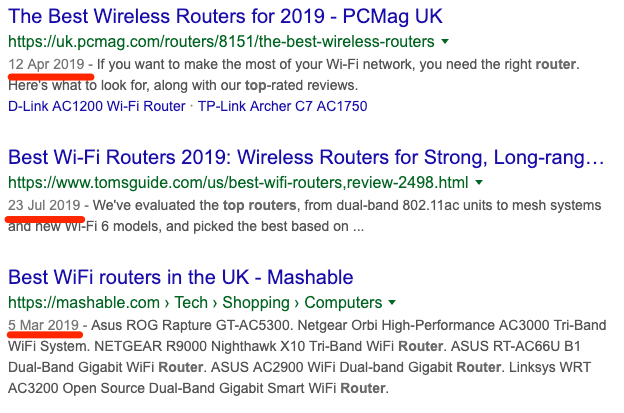
That happens because technology moves fast. Nobody wants to know what the best routers were in 2016. That wouldn’t be useful.
For other queries, freshness is less of a deciding factor.
Take a look at this top-ranking result for “how to tie a tie”:

Nobody has updated the page for over six years, but it doesn’t matter because the way you tie a tie is the same now as it was then.
Look at the search results for your target keyword to see whether freshness is seemingly an important ranking factor. Adjust your strategy as appropriate.
Google looks at factors like location, past search history, and search settings to “tailor your results to what is most useful and relevant for you in that moment.”
That means even if you see your site ranking #1 for your target keyword, that might not be the case for everyone at all times.
For example, if you search for “flapjack recipe” in the UK vs. the US, the results are different.

US results for “flapjack recipe.”

UK results for “flapjack recipe.”
Why? In the UK, flapjacks are oat bars. In the US, they’re pancakes.
To check “true” rankings, use an incognito tab to offset any personalization from your search history. To offset location factors, use VPN.
Alternatively, you can use a rank tracking tool like Ahrefs Rank Tracker to track keywords for a specific location—right down to the zip code. This is especially useful for local SEO.
![]()
That said, rankings still fluctuate.
Here are our rankings for “SEO audit” over the past year:
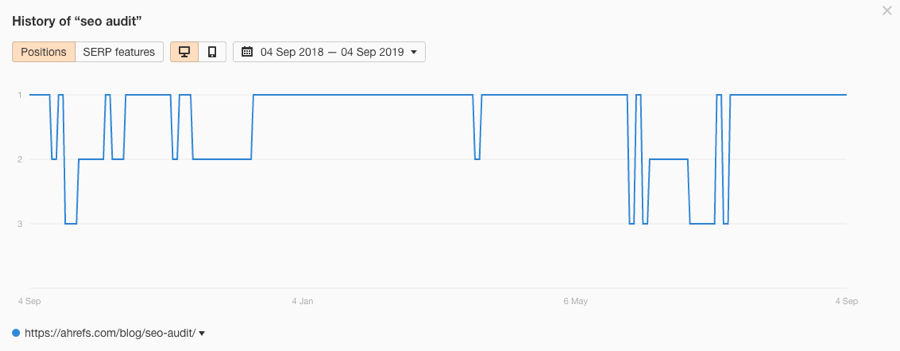
For that reason, it’s often better to pay more attention to organic traffic over rankings.
You can do this with analytics tools like Google Analytics, or you can get a rough estimate in Ahrefs Site Explorer.
Just paste in a URL, then go to the “Organic traffic” tab on the “Overview” report.
For important pages on your site, what you want to see is a graph like this:

Showing organic traffic on the rise.
Or this:

Showing consistent organic traffic over time.
Not this:
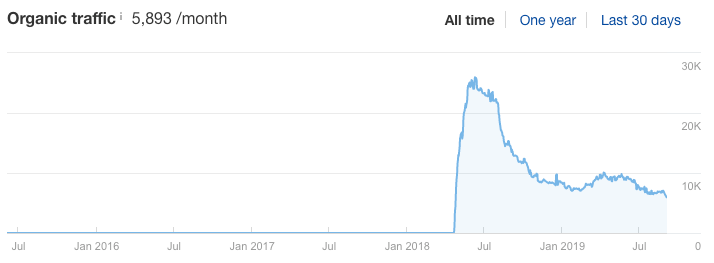
Showing declining organic traffic.
The reason it makes more sense to pay attention to traffic over keyword rankings is that many pages rank for thousands of keywords. And they often get traffic from many of these keywords—not just one.
Final thoughts
Knowing how search engines work and the attributes they’re looking for when ranking content is crucial when trying to create content that ranks.
That said, search engine algorithms change all the time and there’s no guarantee that what’s important today will still be important next year.
Don’t let that panic you. Generally speaking, the important things stay consistent over time.
Factors like backlinks, “authority,” and matching search intent have been critical factors for many years—and there’s no sign of that changing any time soon.
Looking to learn more about SEO? Check out our SEO tutorial.
https://www.youtube.com/watch?v=DvwS7cV9GmQ
Got questions? Leave a comment or ping me on Twitter.
Sidenote.
In the previous version of this post, we asked 40+ SEO industry experts to define SEO. Check out their definitions here.
